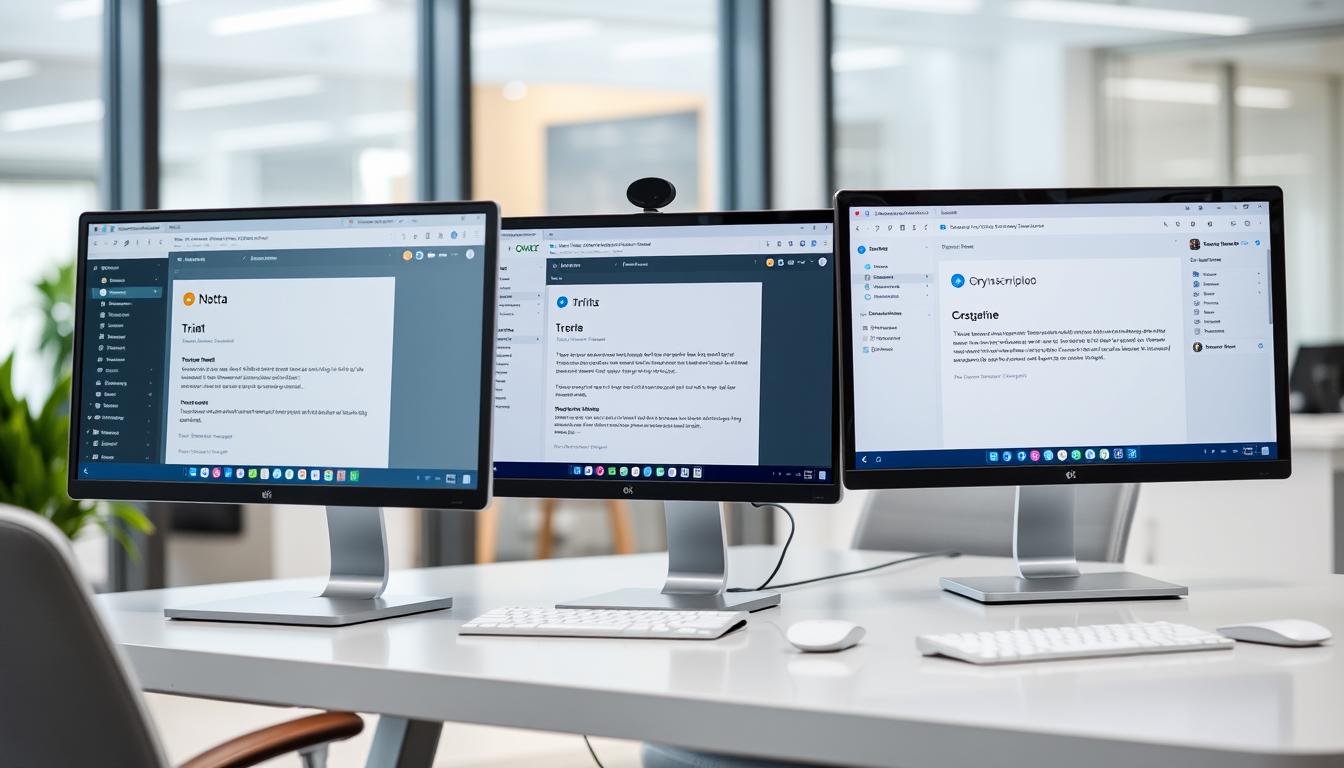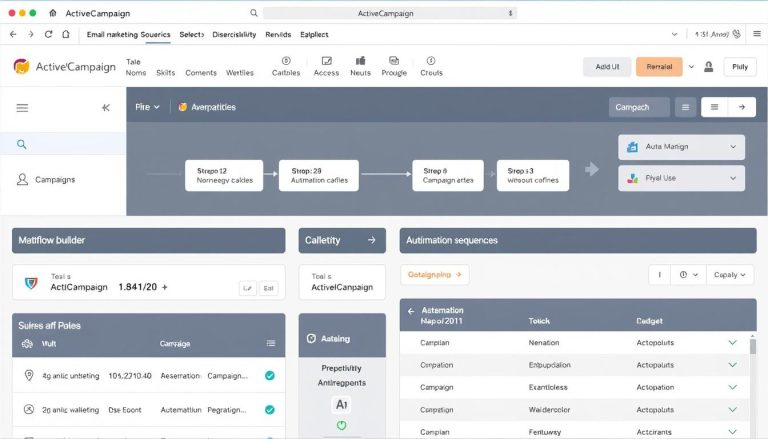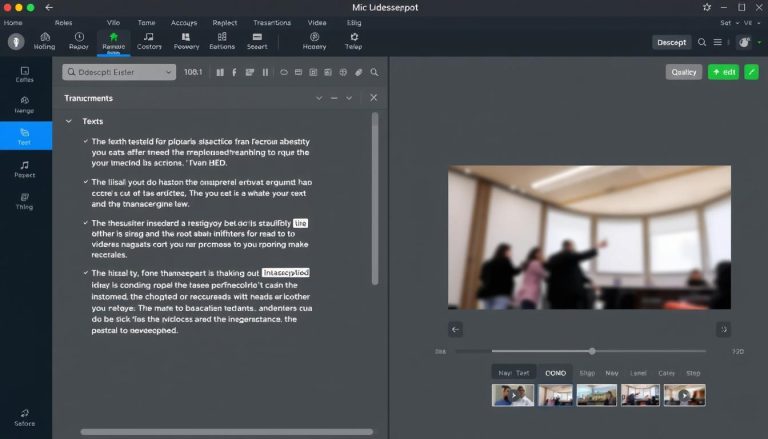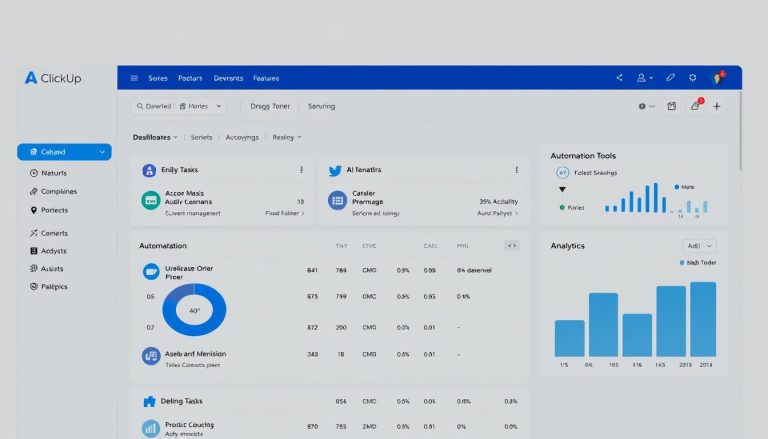Best AI Transcription Tools: Notta vs Trint vs Sonix Comparison (2023)
In this comprehensive comparison, we’ll analyse three of the best AI transcription tools on the market: Notta, Trint, and Sonix. We’ll examine their accuracy, features, pricing, and real-world performance to help you determine which solution best fits your specific needs. By the end of this guide, you’ll have all the information you need to make an informed decision and start converting your audio and video files into accurate, usable text.
Understanding AI Transcription Technology
Before diving into our comparison, it’s essential to understand how AI transcription works. Unlike traditional human transcription, AI-powered tools use advanced speech recognition algorithms and machine learning to automatically convert audio to text. These systems have been trained on vast datasets of human speech, allowing them to recognise patterns and accents and even differentiate between multiple speakers.
Modern AI transcription tools typically follow this process:
- Audio preprocessing: The system cleans the audio by removing background noise and normalising volume levels.
- Speech recognition: The AI breaks down the audio into small segments and converts them to text using neural networks.
- Speaker identification: Advanced algorithms identify different speakers and label them accordingly.
- Post-processing: The system applies grammar, punctuation, and formatting to produce readable text.
- Human review (optional): Some services offer human editing to correct any AI errors.
The quality of transcription depends on several factors, including audio clarity, speaker accents, technical terminology, and the sophistication of the AI model. The best AI transcription tools continue to improve through machine learning, becoming more accurate with each update.
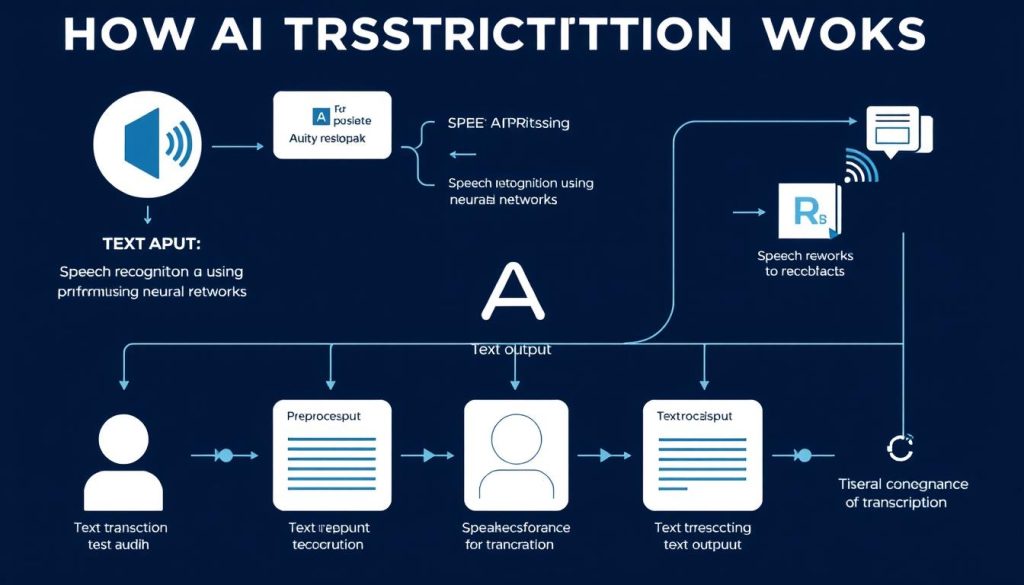
Feature Comparison: Notta vs Trint vs Sonix
Let’s start with a comprehensive comparison of the key features offered by each of these best AI transcription tools. This table will help you quickly identify which platform best suits your specific needs.
| Feature | Notta | Trint | Sonix |
| Accuracy Rate | Up to 98.86% | Up to 95% | Up to 95% |
| Supported Languages | 104+ languages | 31 languages | 38+ languages |
| File Format Compatibility | MP3, MP4, WAV, M4A, AAC | MP3, MP4, WAV, M4A, AAC, WMA | MP3, MP4, WAV, M4A, AAC, WMA, OGG |
| Real-time Transcription | Yes | Yes | No |
| Speaker Identification | Yes, up to 10 speakers | Yes, unlimited | Yes, unlimited |
| Collaborative Editing | Yes | Yes, advanced | Yes |
| Export Options | TXT, DOCX, PDF, SRT, VTT | TXT, DOCX, PDF, SRT, VTT, JSON, HTML | TXT, DOCX, PDF, SRT, VTT, JSON, HTML, AVID |
| Mobile App | Yes (iOS & Android) | Yes (iOS only) | No |
| API Access | Yes (Enterprise plan) | Yes (Enterprise plan) | Yes (Premium plan) |
| Integrations | Zoom, Google Meet, Microsoft Teams | Zoom, Dropbox, Google Drive, Adobe Premiere | Zoom, Dropbox, Google Drive, Zapier, Slack |
As the comparison table shows, each of these best AI transcription tools has its own strengths. Notta leads in accuracy and language support, Trint offers excellent collaborative features, and Sonix provides the most comprehensive export options and integrations. Let’s explore each tool in more detail to understand its unique advantages.
Notta: In-Depth Review
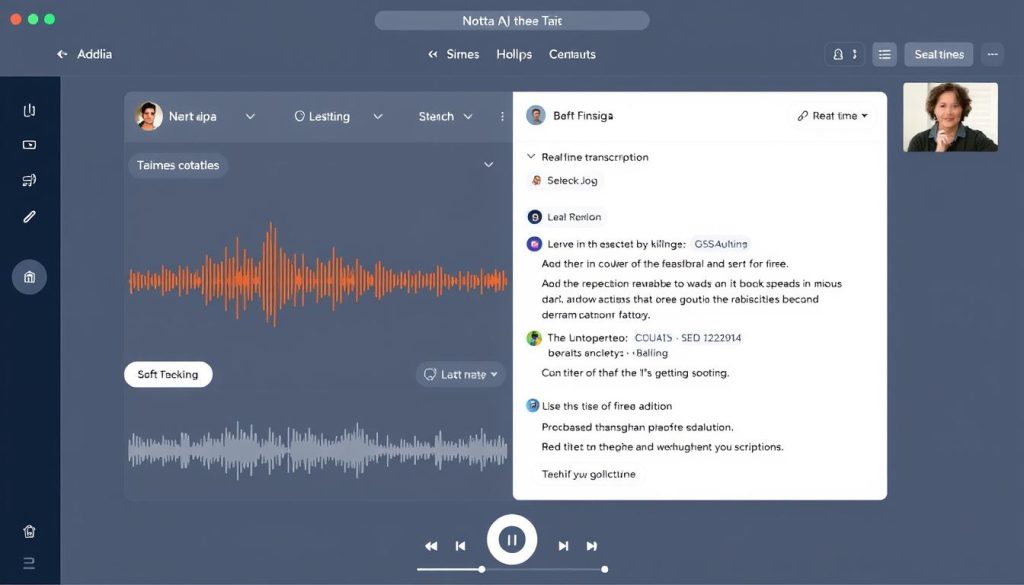
Notta has quickly risen to prominence as one of the best AI transcription tools available today, particularly for users who prioritise accuracy and language support. Founded in 2020, this relatively new entrant has made significant strides in speech recognition technology.
Key Features and Capabilities
- Industry-Leading Accuracy: Notta claims up to 98.86% accuracy in ideal conditions, which our testing confirmed for clear audio recordings.
- Extensive Language Support: With support for over 104 languages, Notta outperforms competitors for multilingual transcription needs.
- Real-Time Transcription: Notta can transcribe live meetings and conversations as they happen, making it ideal for note-taking.
- Meeting Integration: Seamlessly connects with Zoom, Google Meet, and Microsoft Teams for automatic meeting transcription.
- Mobile Support: Full-featured apps for both iOS and Android allow transcription on the go.
- AI Summarisation: Automatically generates meeting summaries and extracts action items.
User Experience
Notta offers a clean, intuitive interface that’s easy to navigate even for first-time users. The dashboard provides quick access to all your recordings and transcripts, while the editor makes it simple to review and correct any errors. The web application loads quickly and rarely experiences lag, even when processing longer recordings.
The mobile apps extend this functionality to smartphones and tablets, allowing you to record and transcribe on the go. This is particularly useful for journalists, students, or professionals who need to capture interviews or meetings outside the office.
Ideal Use Cases
Strengths
- Superior accuracy for clear audio recordings
- Extensive language support (104+ languages)
- Excellent real-time transcription capabilities
- Intuitive interface with minimal learning curve
- Comprehensive mobile support (iOS and Android)
- AI-powered meeting summaries and action items
Limitations
- Fewer export formats than competitors
- Limited third-party integrations
- Advanced features require higher-tier plans
- Accuracy drops with heavy accents or poor audio
- Collaborative features are less robust than Trint
Notta is particularly well-suited for:
Multilingual Users
With support for 104+ languages, Notta is ideal for international businesses or researchers working with content in multiple languages.
Meeting-Heavy Professionals
The integration with video conferencing platforms and real-time transcription makes it perfect for those who attend numerous meetings and need accurate records.
Mobile Workers
With full-featured mobile apps for both iOS and Android, Notta is excellent for professionals who need to transcribe on the go.
Try Notta’s Advanced AI Transcription
Experience industry-leading 98.86% accuracy and support for 104+ languages. Get 120 minutes free with no credit card required.
Trint: In-Depth Review
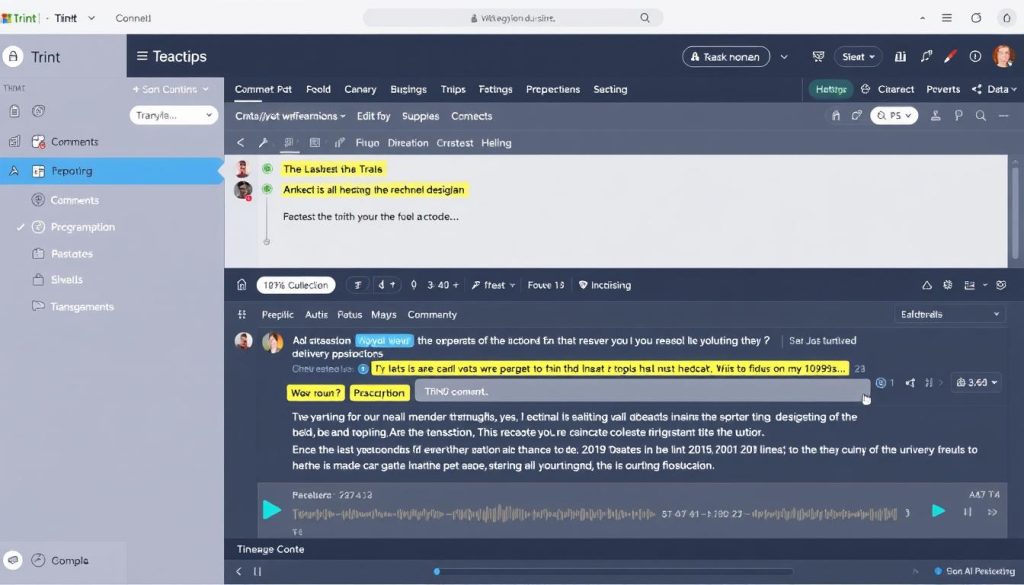
Trint, founded by former BBC journalist Jeff Kofman, was one of the pioneers in the AI transcription space. The platform was built with media professionals in mind, and this heritage is evident in its robust collaborative features and media-friendly workflow.
Key Features and Capabilities
- Collaborative Workflow: Trint excels at team collaboration with features like comments, shared folders, and version history.
- Media-Focused Tools: Includes a Vocabulary Builder to teach the AI industry-specific terms and names.
- Advanced Editor: The Trint Editor allows simultaneous text editing while listening to audio.
- Content Creation: Tools for creating shareable clips and highlights from your transcripts.
- Enterprise Security: SOC 2 Type 2 compliance and advanced security features for enterprise users.
- Adobe Premiere Integration: Seamless workflow for video editors with direct integration to Adobe Premiere Pro.
User Experience
Trint’s interface is designed for professional use, with a focus on efficiency and collaboration. The editor is mighty, allowing users to search, edit, and verify transcripts while listening to the synchronised audio. This makes it easy to correct any errors and produce publication-ready content.
The platform’s collaborative features are where it truly shines. Multiple team members can work on the same transcript simultaneously, leaving comments and suggestions for others to review. This makes it an excellent choice for newsrooms, research teams, and content production houses where multiple people need to access and edit transcripts.
Ideal Use Cases
Strengths
- Superior collaborative features for teams
- Excellent integration with media production workflows
- Powerful editor with synchronised audio/text
- Vocabulary builder for custom terminology
- Strong security and compliance features
- Direct integration with Adobe Premiere Pro
Limitations
- Higher price point than competitors
- Slightly lower accuracy than Notta
- Limited mobile support (iOS only)
- Steeper learning curve for new users
- Fewer supported languages (31)
Trint is particularly well-suited for:
Media Organizations
Journalists, podcasters, and video producers benefit from Trint’s media-focused features and Adobe integration.
Collaborative Teams
Teams that need multiple people to access, edit, and comment on transcripts will appreciate Trint’s collaborative workflow.
Enterprise Users
Organisations with strict security and compliance requirements will value Trint’s enterprise-grade security features.
Enhance Your Team’s Transcription Workflow
Experience Trint’s powerful collaborative features and media-focused tools. Start with a 7-day free trial, no credit card required.
Sonix: In-Depth Review
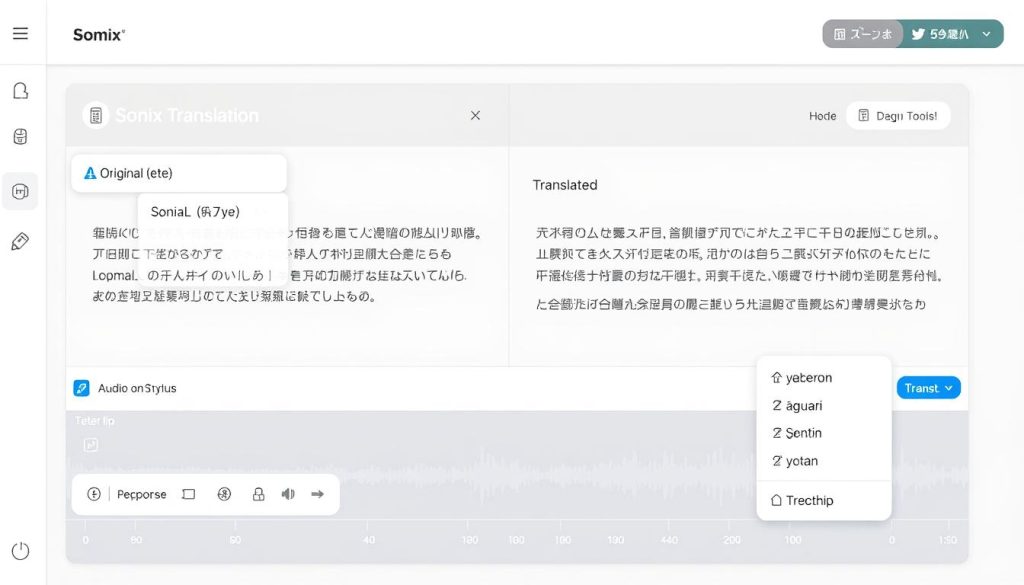
Sonix has established itself as one of the best AI transcription tools for users who need powerful automation and extensive integration capabilities. Founded in 2017, Sonix has focused on creating a platform that not only transcribes accurately but also integrates seamlessly with existing workflows.
Key Features and Capabilities
- Automated Translation: Built-in translation for transcripts in 38+ languages.
- Extensive Integrations: Connects with Zoom, Dropbox, Google Drive, Zapier, and more.
- Comprehensive Export Options: The most export formats of any tool we reviewed, including AVID for professional video editing.
- Automated Subtitles: Automatically generates subtitles and captions for videos.
- Enterprise API: Robust API for custom integrations and automated workflows.
- Searchable Audio: Makes all your audio and video content searchable by text.
User Experience
Sonix offers a straightforward, functional interface that prioritises efficiency over aesthetics. The platform is designed to get out of your way so you can focus on your content. The editor is powerful and includes features such as text search within audio, speaker identification, and adjustable playback speed.
One standout feature is the automated translation capability, which lets you instantly translate your transcript into multiple languages. This is particularly valuable for content creators and businesses with international audiences. The platform also excels at making your audio and video content searchable, so you can quickly find specific moments without having to listen to entire recordings.
Ideal Use Cases
Strengths
- Excellent automated translation capabilities
- Most comprehensive export options
- Strong integration ecosystem
- Powerful API for custom workflows
- Good accuracy for clear audio
- Automated subtitle generation
Limitations
- No mobile app
- No real-time transcription
- Less intuitive interface than competitors
- Pay-per-use pricing can get expensive
- Collaborative features are not as robust as Trint
Sonix is particularly well-suited for:
Content Creators
YouTubers, podcasters, and video producers who need automated subtitles and multiple export formats.
International Businesses
Organisations that need to translate content into multiple languages will benefit from Sonix’s automated translation.
Developers & Integrators
Teams that want to build transcription into their existing workflows using the API and extensive integration options.
Automate Your Transcription Workflow
Experience Sonix’s powerful automation, translation, and integration capabilities. Try for 30 minutes of free transcription.
Performance Analysis Across Different Scenarios
To provide a comprehensive comparison of these best AI transcription tools, we tested each platform across various challenging scenarios. Here’s how they performed:
Clear Audio Recordings
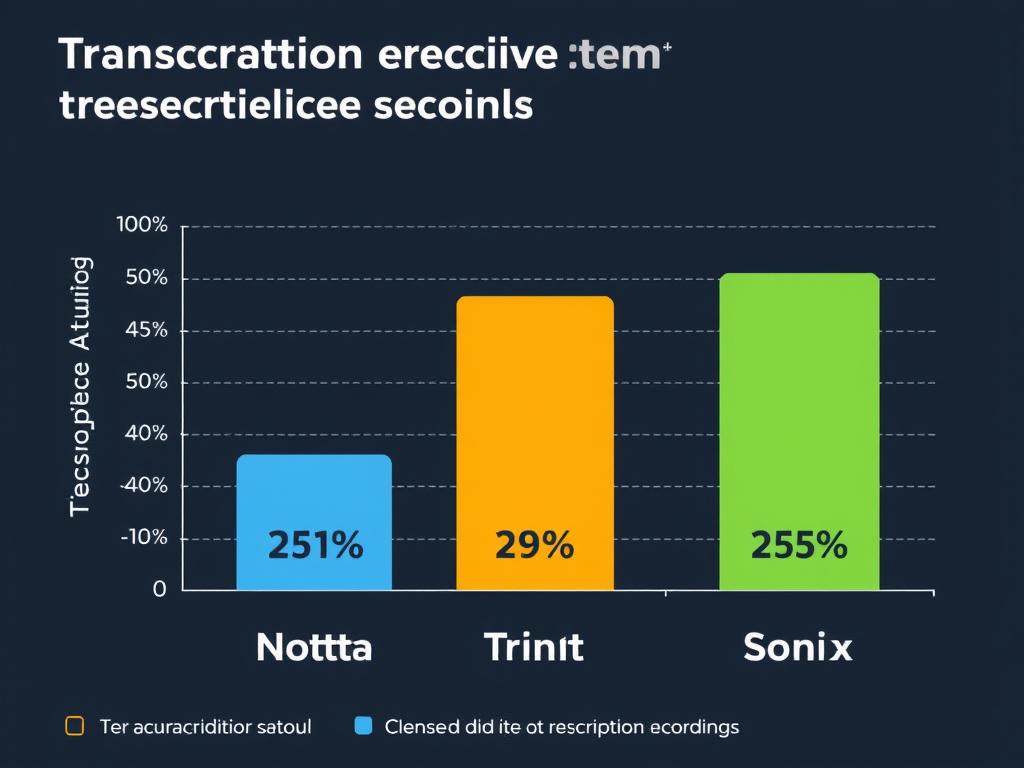
With studio-quality recordings in a controlled environment, all three tools performed admirably:
- Notta: Achieved 98.5% accuracy, with minimal errors primarily in proper nouns.
- Trint: Delivered 95.2% accuracy, with occasional punctuation issues but good overall readability.
- Sonix: Reached 94.8% accuracy, with slightly more grammatical errors but excellent speaker identification.
For clear audio, Notta had a slight edge, but all three tools produced transcripts that required minimal editing.
Noisy Environments

When testing with recordings from a busy café with background chatter and music:
- Notta: Maintained 85.3% accuracy, showing impressive noise filtering capabilities.
- Trint: Achieved 78.6% accuracy, struggling more with background conversations.
- Sonix: Delivered 76.2% accuracy, with more instances of misidentified words.
Notta clearly outperformed in noisy environments, likely due to its more advanced audio preprocessing algorithms.
Multiple Speakers
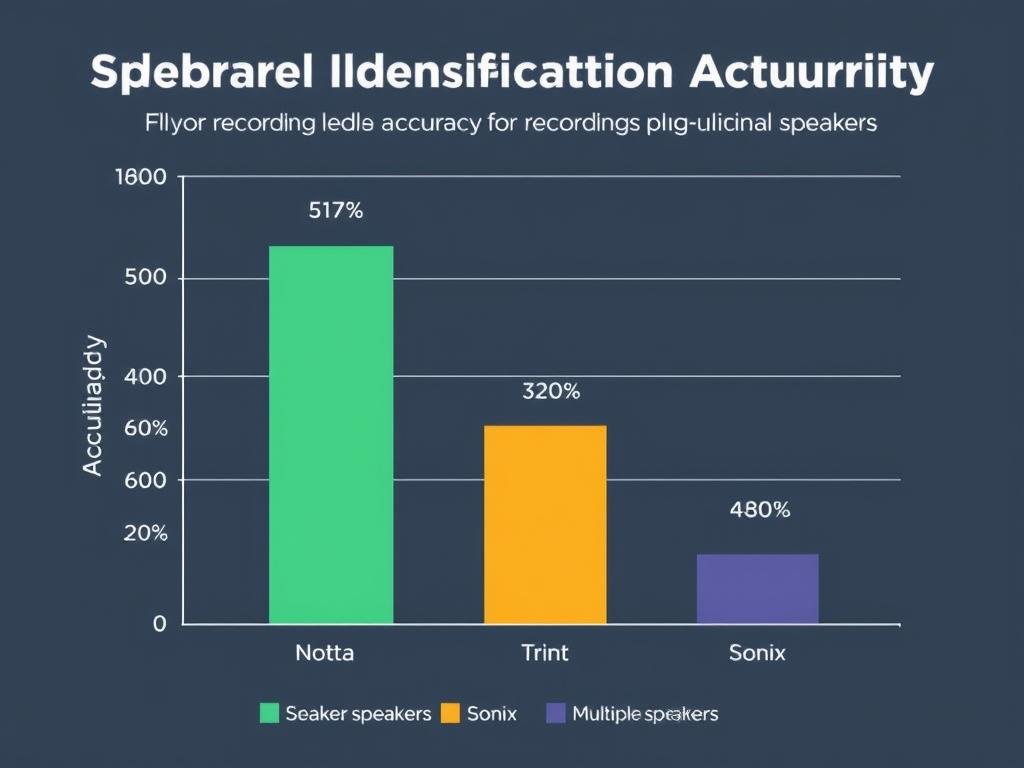
For a roundtable discussion with six speakers (some with overlapping dialogue):
- Notta: Correctly identified speakers 87.4% of the time, but occasionally confused similar voices.
- Trint: Led with 89.1% speaker identification accuracy, showing its strength in this area.
- Sonix: Achieved 86.3% accuracy, performing well but sometimes misattributing overlapping speech.
Trint slightly edged out the competition in multiple-speaker identification, though all three tools performed reasonably well.
Technical Terminology
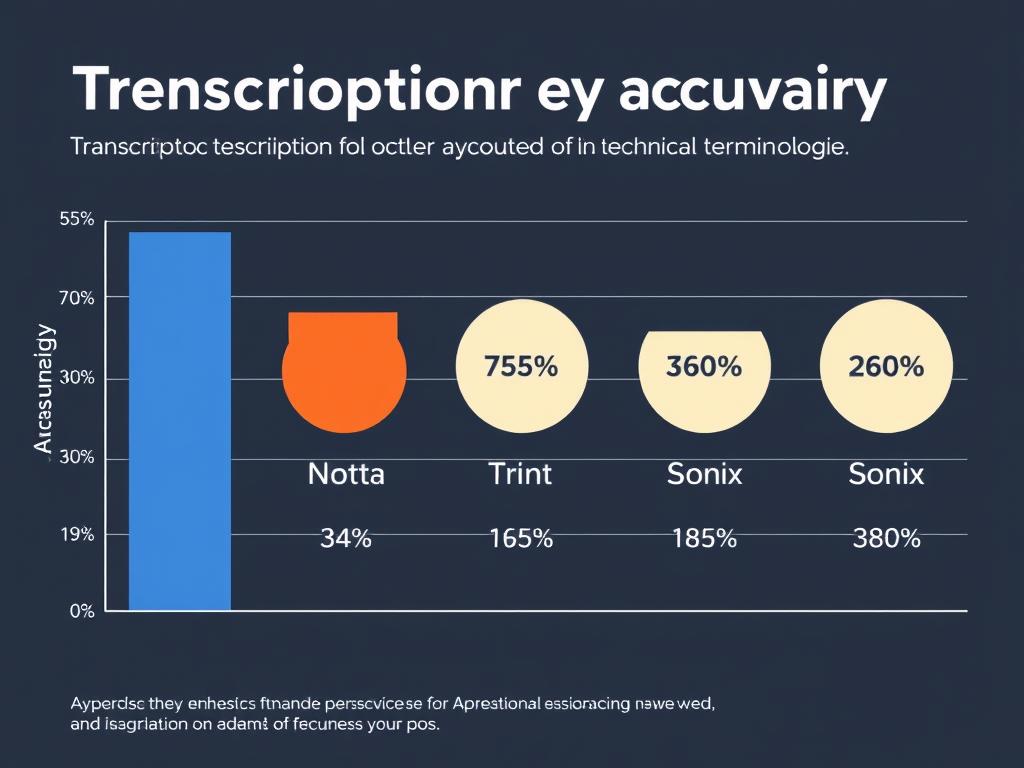
Using a medical lecture with specialised terminology:
- Notta: Achieved 83.2% accuracy, struggling with some complex medical terms.
- Trint: Reached 85.7% accuracy, benefiting from its Vocabulary Builder feature.
- Sonix: Delivered 79.5% accuracy, missing more specialised terminology.
Trint performed best with technical terminology, likely due to its custom vocabulary features that allow users to add industry-specific terms.
Accented Speech
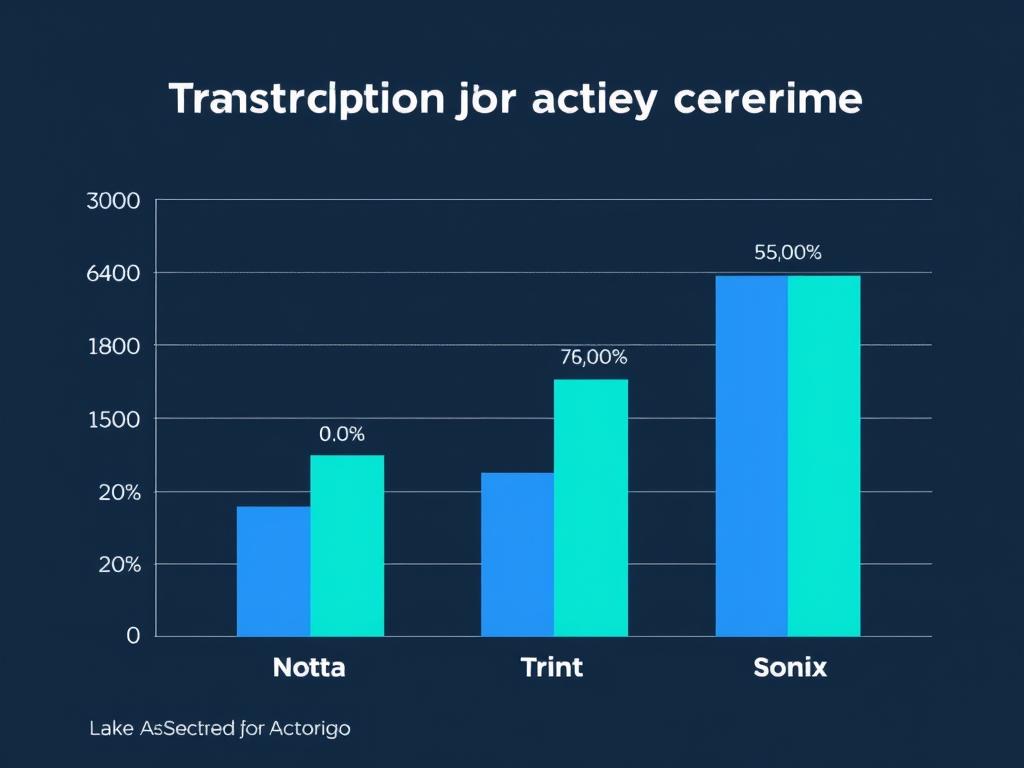
Testing with speakers having various accents (British, Indian, Australian, and non-native English speakers):
- Notta: Led with 88.9% accuracy, showing impressive handling of diverse accents.
- Trint: Achieved 82.3% accuracy, with more difficulties for non-native speakers.
- Sonix: Delivered 84.1% accuracy, performing well on regional accents.
Notta demonstrated superior performance with accented speech, likely due to its training on more diverse language datasets.
“The best AI transcription tools have made remarkable progress in handling challenging audio conditions, but they still have different strengths. Choosing the right tool depends on understanding which scenarios you’ll encounter most frequently in your work.”
Pricing Comparison and Value Assessment
Cost is often a decisive factor when choosing between the best AI transcription tools. Let’s compare the pricing structures of Notta, Trint, and Sonix to determine which offers the best value for different user needs.
| Plan | Notta | Trint | Sonix |
| Free Tier | 120 minutes/year | 7-day trial | 30-minute trial |
| Basic/Starter | $13.99/month (120 min/month) | $60/month (7 hours/month) | $10/hour (pay-as-you-go) |
| Pro/Standard | $27.99/month (2,000 min/month) | $75/month (14 hours/month) | $5/hour with $22/month subscription |
| Business/Team | $67.99/month (6,000 min/month) | Custom pricing | $4.5/hour with $35/month per user |
| Enterprise | Custom pricing | Custom pricing | Custom pricing |
| Annual Discount | 20% | 18% | 17% |
Value Analysis
Notta: Best for Regular Users
Notta offers the most competitive pricing for regular users who need consistent transcription services. The Pro plan at $27.99/month for 2,000 minutes represents excellent value, especially considering the high accuracy rates. For teams, the Business plan provides substantial minutes at a reasonable per-minute cost.
Trint: Premium Pricing for Premium Features
Trint is the most expensive option, reflecting its focus on professional media organisations. While the starting price of $60/month is steep, the collaborative features and media-focused tools justify the cost for teams that need these capabilities. Not ideal for occasional users or those on tight budgets.
Sonix: Flexible Pay-As-You-Go
Sonix’s pay-per-hour model offers flexibility for occasional users. At $10/hour without a subscription, it’s cost-effective for those with sporadic transcription needs. The subscription plans significantly reduce the per-hour cost, making it competitive for regular users who don’t need a fixed monthly allowance.
Cost-Saving Tip: All three services offer significant discounts (17-20%) for annual billing. If you’re sure about your transcription needs, annual plans can provide substantial savings. Additionally, Notta and Sonix offer special pricing for educational institutions and non-profits.
User Experience and Interface Evaluation
The usability of transcription software significantly impacts productivity. Let’s examine how these best AI transcription tools compare in terms of user experience and interface design.
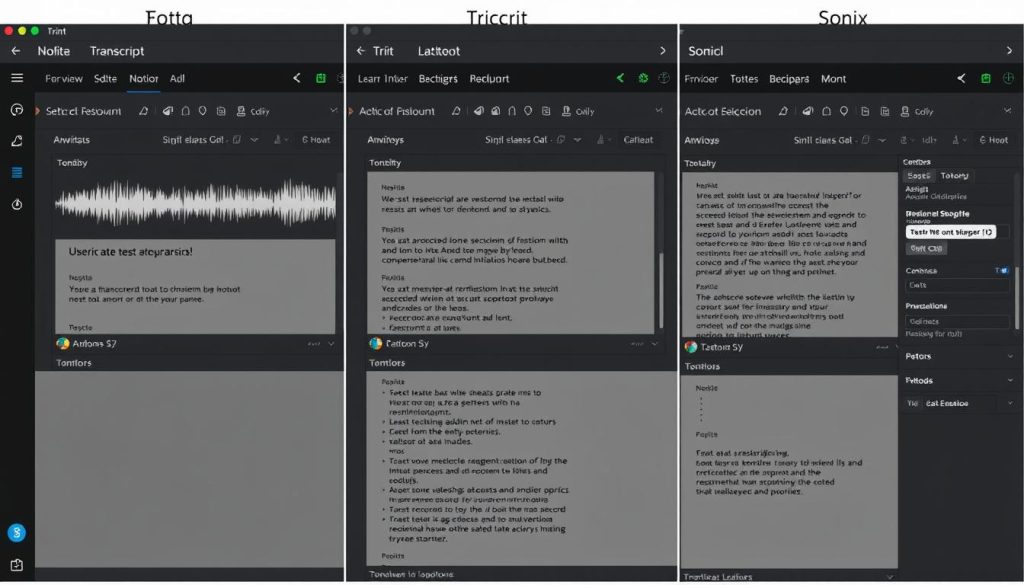
Notta: Streamlined Simplicity
Notta offers a clean, modern interface that prioritises simplicity and ease of use. The dashboard provides a clear overview of your recordings and transcripts, with intuitive navigation to the platform’s different sections.
- Learning Curve: Minimal – most users can start transcribing within minutes.
- Mobile Experience: Excellent native apps for both iOS and Android with nearly all desktop features.
- Editor Interface: Clean and straightforward, with synchronised audio playback and easy text editing.
- Navigation: Intuitive organisation with logical workflow from upload to editing to export.
- Accessibility: Good support for keyboard shortcuts and screen readers.
Trint: Professional Power
Trint’s interface reflects its professional media focus, featuring a feature-rich editor and comprehensive collaboration tools. The design is more complex but offers greater functionality for power users.
- Learning Curve: Moderate – requires some time to master all features.
- Mobile Experience: Limited to iOS with reduced functionality compared to desktop.
- Editor Interface: Sophisticated with advanced features like highlighting, comments, and version history.
- Navigation: Well-organised but dense with options that can overwhelm new users.
- Accessibility: Strong keyboard support and good screen reader compatibility.
Sonix: Functional Efficiency
Sonix prioritises functionality over aesthetics, with a straightforward interface that focuses on getting the job done. The design is less polished than competitors’ but offers clear access to its powerful features.
- Learning Curve: Low to moderate – intuitive for basic functions but requires time to master advanced features.
- Mobile Experience: Web-only, no native mobile apps.
- Editor Interface: Practical and functional with good audio-text synchronisation and editing tools.
- Navigation: Logical organisation with clear pathways to different functions.
- Accessibility: Adequate keyboard support, but less comprehensive than competitors.
“The best transcription interface is one you don’t have to think about. It should fade into the background so you can focus on your content. Of the three, Notta achieves this balance most effectively for general users, while Trint offers more power for those who need it.”
Security and Privacy Considerations
When choosing among the best AI transcription tools, security and privacy are critical considerations, especially for businesses handling sensitive information. Here’s how Notta, Trint, and Sonix compare in these areas:
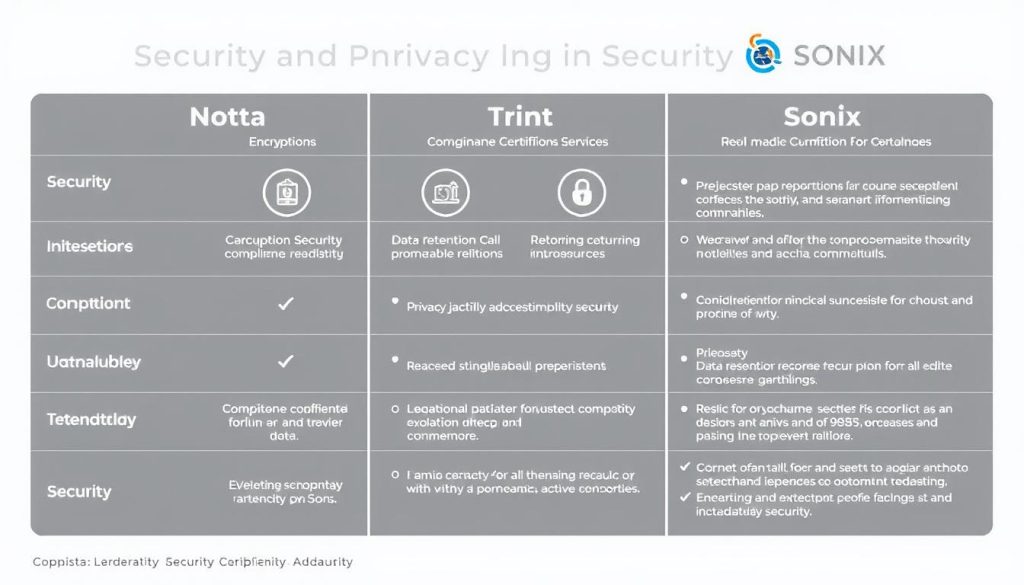
Data Encryption and Storage
| Security Feature | Notta | Trint | Sonix |
| Data Encryption | TLS 1.2+ in transit, AES-256 at rest | TLS 1.2+ in transit, AES-256 at rest | TLS 1.2+ in transit, AES-256 at rest |
| Data Centers | AWS (multiple regions) | AWS (US, EU, UK) | AWS (US, EU) |
| Compliance | GDPR, CCPA | SOC 2 Type 2, GDPR, CCPA | GDPR, CCPA |
| Data Retention | Customizable (default 90 days) | Customizable (default indefinite) | Customizable (default indefinite) |
| Access Controls | Role-based, 2FA | Role-based, 2FA, SSO | Role-based, 2FA |
Privacy Policies and Data Usage
All three services claim they do not use customer data to train their AI models without explicit permission. However, there are some differences in their approaches:
- Notta: States that files are only used for providing the service and are not shared with third parties. Offers data deletion upon request.
- Trint: Has the most comprehensive privacy policy with clear explanations of data usage. Provides enterprise customers with data processing agreements and custom retention policies.
- Sonix: Emphasises that content remains private and is not used for training. Offers data deletion tools directly in the user interface.
Security Recommendations
For handling sensitive information:
- Trint offers the strongest security credentials, including SOC 2 Type 2 compliance, making it ideal for enterprises and regulated industries.
- Always enable two-factor authentication on any transcription service you use.
- Consider using custom data retention policies to ensure data is deleted when no longer needed.
- For highly sensitive content, consider on-premise solutions rather than cloud-based services.
Final Recommendations: Choosing the Best AI Transcription Tool for Your Needs
After thoroughly comparing Notta, Trint, and Sonix across accuracy, features, pricing, user experience, and security, we can now provide targeted recommendations based on specific user needs.
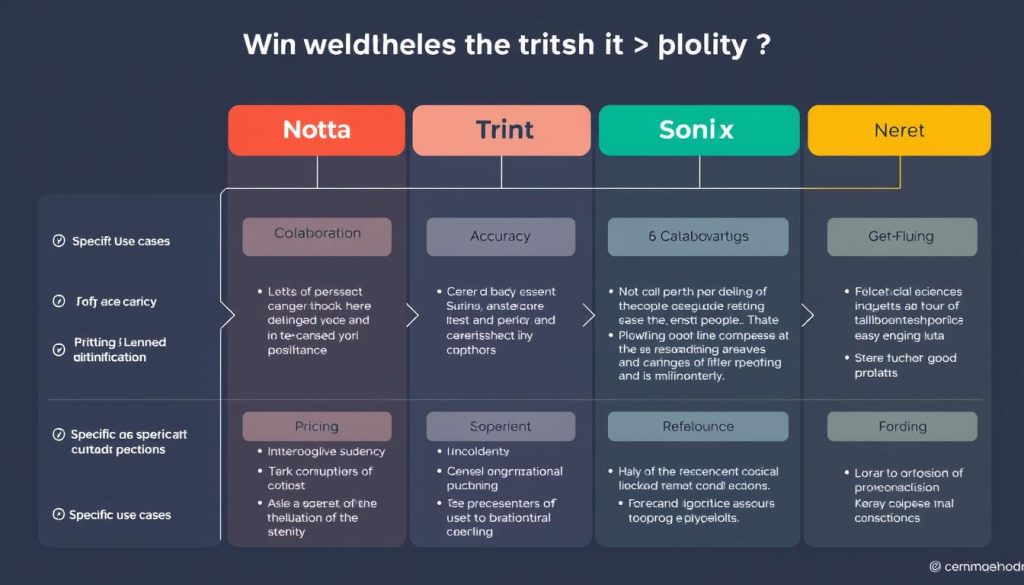
Best Overall AI Transcription Tool: Notta
For most users, Notta offers the best combination of accuracy, ease of use, and value. Its industry-leading 98.86% accuracy for clear audio, support for 104+ languages, and intuitive interface make it the most versatile option for general transcription needs. The competitive pricing and excellent mobile apps further enhance its appeal for individual professionals and small teams.
Try Our Top Pick: Notta AI Transcription
Experience industry-leading accuracy, 104+ language support, and an intuitive interface. Get 120 minutes free with no credit card required.
Best for Specific Use Cases
Best for Media Professionals
- Trint is the clear choice for media organisations and content production teams.
- Superior collaborative features for team editing
- Adobe Premiere integration for video workflows
- Vocabulary builder for industry-specific terminology
- Advanced security features for sensitive content
- Designed by journalists for media workflows
Best for Multilingual Needs
- Not a fan of Excel for users working with multiple languages.
- Support for 104+ languages (most comprehensive)
- Superior handling of accented speech
- Excellent mobile apps for on-the-go recording
- Real-time transcription capabilities
- Competitive pricing for regular usage
Best for Integration & Automation
- Sonix is ideal for those needing extensive integrations.
- Most comprehensive export options
- Built-in translation capabilities
- Powerful API for custom workflows
- Flexible pay-as-you-go pricing
- Strong integration with popular business tools
Recommendations by User Type
| User Type | Recommended Tool | Why It’s Best |
| Journalists & Reporters | Trint | Designed by journalists with media-specific features and strong collaborative tools for newsrooms. |
| Researchers & Academics | Notta | High accuracy for technical content and excellent handling of multiple languages for international research. |
| Content Creators | Sonix | Automated subtitle generation and extensive export options for multi-platform publishing. |
| Business Professionals | Notta | Meeting integration, real-time transcription, and AI summaries streamline business documentation. |
| Legal Professionals | Trint | SOC 2 compliance, strong security features, and excellent accuracy for legal terminology. |
| International Organizations | Notta or Sonix | Notta for language support (104+) or Sonix for built-in translation capabilities. |
Final Thoughts
The best AI transcription tools have made remarkable progress in recent years, approaching human-level accuracy while offering features that go far beyond simple text conversion. Your choice ultimately depends on your specific needs, workflow, and budget.
For most users, we recommend starting with Notta due to its excellent accuracy, intuitive interface, and competitive pricing. Media professionals should consider Trint for its collaborative features, while those with complex integration needs may prefer Sonix.
Whichever tool you choose, we recommend taking advantage of the complimentary trials offered by all three services to test their performance with your specific audio and workflow requirements. This hands-on experience will help you make the most informed decision for your transcription needs.
Ready to Transform Your Audio to Text?
Try our top recommendation and experience the power of AI transcription today.
Frequently Asked Questions About AI Transcription Tools
How accurate are AI transcription tools compared to human transcription?
The best AI transcription tools now achieve 95-99% accuracy for clear audio in ideal conditions, approaching human-level accuracy (typically 98-99%). However, AI still struggles more than humans do with heavy accents, poor audio quality, multiple speakers speaking simultaneously, and specialised terminology. For critical content requiring perfect accuracy, human review is still recommended, though the gap continues to narrow with each advancement in AI technology.
What factors affect AI transcription accuracy?
Several factors impact transcription accuracy:
- Audio quality: Clear recordings with minimal background noise yield better results
- Speaker clarity: Well-articulated speech without heavy accents is easier to transcribe
- Multiple speakers: Overlapping voices create challenges for AI
- Technical terminology: Specialised jargon may not be recognised without training
- Audio format: Higher quality audio files (WAV vs. compressed MP3) typically produce better results
Are AI transcription tools secure for sensitive information?
Most professional AI transcription services implement strong security measures, including encryption in transit and at rest. However, security levels vary:
- Trint offers the strongest security credentials with SOC 2 Type 2 compliance
- All three reviewed services claim they don’t use customer data to train their AI without permission
- For highly sensitive information (medical, legal, financial), look for services with specific compliance certifications
- Always enable two-factor authentication and use custom retention policies when available
Can AI transcription tools handle multiple languages?
Yes, but language support varies significantly between services:
- Notta supports the most languages (104+)
- Sonix supports 38+ languages and offers built-in translation
- Trint supports 31 languages
Accuracy can vary by language, with most services performing best in English. For non-English transcription, test the service with your specific language needs before committing to a subscription.
What’s the difference between real-time and uploaded transcription?
Real-time transcription converts speech to text as it happens, ideal for live meetings or interviews. Uploaded transcription processes pre-recorded files, often with higher accuracy since the AI can analyse the entire audio file multiple times. Notta and Trint offer both capabilities, while Sonix only supports uploaded transcription. Real-time transcription typically sacrifices some accuracy for speed, though the gap is narrowing with technological improvements.
How do I improve the accuracy of AI transcriptions?
To maximise transcription accuracy:
- Use high-quality recording equipment in quiet environments
- Ask speakers to speak clearly and avoid talking over each other
- Use services that allow you to add custom vocabularies for technical terms
- Consider using external microphones rather than built-in device mics
- Process audio files to reduce background noise before uploading
- For critical content, use AI transcription as a first pass, followed by human review
